7.08 till 14.08.2016, 7 days, currency exchange rate 1 € = 1.50 AUD (Australian Dollar)
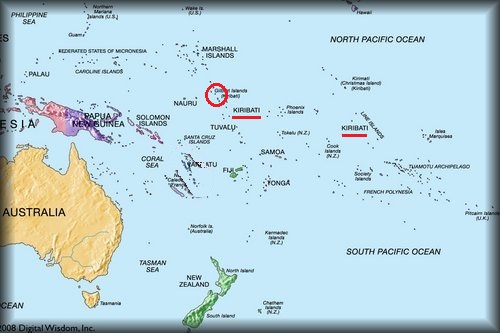

Introduction
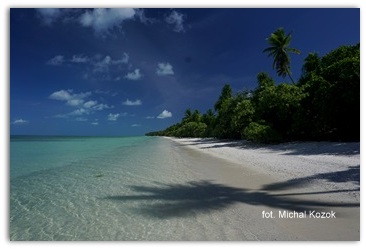 Here, the statistics also make an impression - Kiribati is size of 1/3 of Europe, although the land area of all 33 atolls sum up to 800 square km, size of middle size city. The islands furthest west point to the east one is around 4,000 km, stretching for three different time zones. On the west side are Gilbert Islands, with the capital of Tarawa, in the middle Phoenix Islands, the most rarely visited, and in the east the most popular ones Line Islands (including Christmas Island), with good connection from Hawaii.
Here, the statistics also make an impression - Kiribati is size of 1/3 of Europe, although the land area of all 33 atolls sum up to 800 square km, size of middle size city. The islands furthest west point to the east one is around 4,000 km, stretching for three different time zones. On the west side are Gilbert Islands, with the capital of Tarawa, in the middle Phoenix Islands, the most rarely visited, and in the east the most popular ones Line Islands (including Christmas Island), with good connection from Hawaii.
The most eastern island from Line archipelago is the first place on earth that 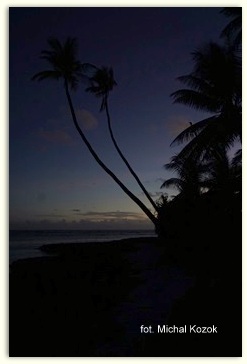 welcome a new day. The islands north and south of it, although the sun shines for them the same way, they still have yesterday. This is good for the country now, because Kiribati was divided by the date line in the past, so that half of the country had a Sunday morning and at the same time the neighbouring islands were already starting their work on Monday. There are 110,000 inhabitants, and half of them live in the capital atoll of Tarawa. This means that apart from Tarawa and the Christmas Island (Kirimati) it is virtually almost deserted.
welcome a new day. The islands north and south of it, although the sun shines for them the same way, they still have yesterday. This is good for the country now, because Kiribati was divided by the date line in the past, so that half of the country had a Sunday morning and at the same time the neighbouring islands were already starting their work on Monday. There are 110,000 inhabitants, and half of them live in the capital atoll of Tarawa. This means that apart from Tarawa and the Christmas Island (Kirimati) it is virtually almost deserted.
I am shocked when I read the World War II history of the islands. There, Japanese-American massacres are counted in thousands of dead men! At Kiribati bunkers, weapons, sunken wrecks of planes and ships are attracting visitors who love that era. I don't care of such attractions.
The current problem is global warming. It seems that Kiribati might be one of the first to feel the effects – their islands will be first to submerge completely under water. For that occasion the government already purchased a piece of land on one of Fijian islands, and will be ready for evacuation of whole nation.
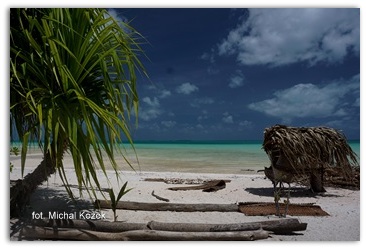


Abaiang

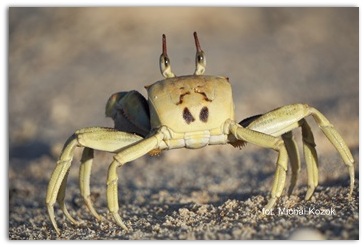 In Tarawa, we were greeted by local tour operator with our domestic tickets, which I bought in Australia, but they are not e-tickets. We were boarding a small propeller plane and flew to the neighbouring archipelago - Abaiang. After a few minutes of a spectacular flight, we landed on the grassy airstrip. Customers left, new ones boarded, the plane flew away. And I did not know where to go. In addition to the fact that we did not want to go to the west end of the island, because there is an official homestay. So, I agreed with the local school director to arrange transport for us. For this purpose, I got a truck at my own disposal, which took us to the northern end of the island - the road ends there.
In Tarawa, we were greeted by local tour operator with our domestic tickets, which I bought in Australia, but they are not e-tickets. We were boarding a small propeller plane and flew to the neighbouring archipelago - Abaiang. After a few minutes of a spectacular flight, we landed on the grassy airstrip. Customers left, new ones boarded, the plane flew away. And I did not know where to go. In addition to the fact that we did not want to go to the west end of the island, because there is an official homestay. So, I agreed with the local school director to arrange transport for us. For this purpose, I got a truck at my own disposal, which took us to the northern end of the island - the road ends there.
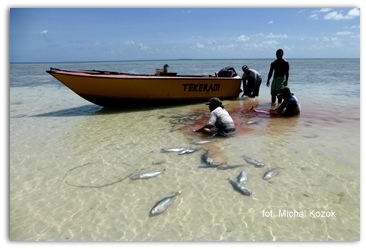 We got out of the truck with the entire stuff. There were some wooden structures nearby, but there was no living soul around. I left my rucksack under the palm tree and walked towards the last village we have passed, where we saw locals on some party event. When we got there, we were kindly welcomed, offered drinks, and locals talked to us. The head of the village agreed to host us, and few moments later two motorbikes were organised to bring us back for our luggage. Our backpacks lay as we left them, no one moved them.
Family who had constructed the nearby structures, automatically became our hosts. It is difficult to call these structures homes, although such function was holding. These are simply floor and roof connected by four poles, no walls, pretty airy. That's how people live in Kiribati. But at least almost everyone had a solar battery funded by the Taiwan government, and therefore there was a lighting at night. We spent first night socializing.
We got out of the truck with the entire stuff. There were some wooden structures nearby, but there was no living soul around. I left my rucksack under the palm tree and walked towards the last village we have passed, where we saw locals on some party event. When we got there, we were kindly welcomed, offered drinks, and locals talked to us. The head of the village agreed to host us, and few moments later two motorbikes were organised to bring us back for our luggage. Our backpacks lay as we left them, no one moved them.
Family who had constructed the nearby structures, automatically became our hosts. It is difficult to call these structures homes, although such function was holding. These are simply floor and roof connected by four poles, no walls, pretty airy. That's how people live in Kiribati. But at least almost everyone had a solar battery funded by the Taiwan government, and therefore there was a lighting at night. We spent first night socializing.

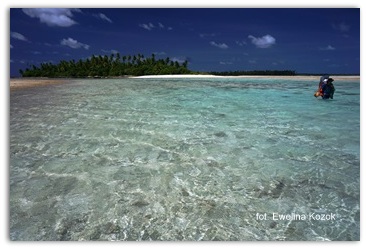
Next day, they locals showed us their homes, farm animals, brought coconuts straight from the palm, accompanying us at bathing, and finally they announced the long-time expected message -  the low tide arrived! We took with us a lot of drinking water, food and a tent - and we entered the sea. The water reached no higher than a calf, sometimes beyond a knee, the hike on the reef was slow but pleasant. We passed several islands, and finally after 5 kilometres (2 hours) we chose one uninhabited island (Riannabaara) for our house for one night. Awesome!
the low tide arrived! We took with us a lot of drinking water, food and a tent - and we entered the sea. The water reached no higher than a calf, sometimes beyond a knee, the hike on the reef was slow but pleasant. We passed several islands, and finally after 5 kilometres (2 hours) we chose one uninhabited island (Riannabaara) for our house for one night. Awesome!
The island wasn't completely uninhabited - I mean there were a lot of birds and crabs. Circumnavigation of the island takes around five minutes, so apart from making campfire, walking on the beach and swimming in turquoise water, chasing crabs, a little more could be done. Then high tide arrived, and we were literally cut off from the world. Nice feeling. I have been looking for such a place on Google Earth for a long time, far and at the same time close to the civilisation. When after around 24-hour period another low tide arrived during the sunlight, we've set off on the way back. Crazy reef sharks were swimming around, extremely fast.
After returning, we caught a school truck, which we rode up to half of the island, and continued the other part on the encountered motorbikes - with a child in the middle and with a backpack on the back.
Tarawa

 Tarawa - after leaving the airport I suggest you take a local transport to Buota. The road ends there and the real Tarawa begins. If you go to the left after leaving the airport, you will see a town with corrugated and concrete infrastructure, a lot of people, urbanised landscaped, no privacy, peace or beauty. I advise to avoid it, unless you have a good reason to do so.
Tarawa - after leaving the airport I suggest you take a local transport to Buota. The road ends there and the real Tarawa begins. If you go to the left after leaving the airport, you will see a town with corrugated and concrete infrastructure, a lot of people, urbanised landscaped, no privacy, peace or beauty. I advise to avoid it, unless you have a good reason to do so.
In Buota, to get to the neighbouring island of Abatao, take a local boat or walk through the channel - depending on the tides. Hence there is only pedestrians path, or for bicycles, which goes to the north. We could see some homesteads and even the official accommodation.
We hiked aimlessly northward for two days, and when dusk approached, we stopped at a nearby homestead and asked about the possibility of pitching the tent. Of course, there was not the slightest problem, we got the opportunity to bathe in a bucket of water, eat fresh 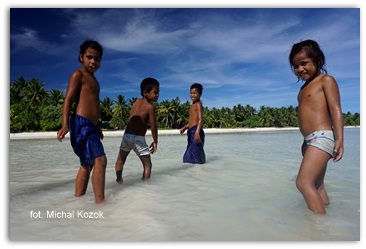 coconuts, boiling water, and even offered to sleep in the homestead and a meal together, but we did not want to overuse their hospitality. Staying a bit on side, we felt more comfortable.
coconuts, boiling water, and even offered to sleep in the homestead and a meal together, but we did not want to overuse their hospitality. Staying a bit on side, we felt more comfortable.
Here you could also feel the Micronesian lifestyle - they live from what nature brings them - the sea and the earth. They live traditionally, but they seem to be happy. After a few days of carefree wandering between the islands and their inhabitants, we returned to the airport.

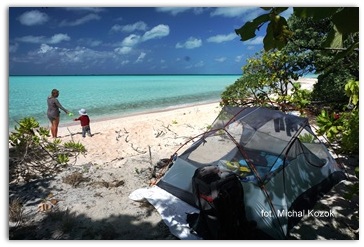 accommodation – I did not use the official one. However, I encountered three accommodation possibilities north of the airport - everywhere the price was the same as AUD 50 per person per night. There is also the possibility of buying some meals.
accommodation – I did not use the official one. However, I encountered three accommodation possibilities north of the airport - everywhere the price was the same as AUD 50 per person per night. There is also the possibility of buying some meals.
Abaiang
There is a homestay at the southwestern tip of Abaiang Island. However, we were interested in the northern part because of the possibility of walking to neighbouring islands during low tide.
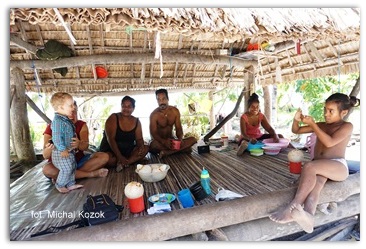
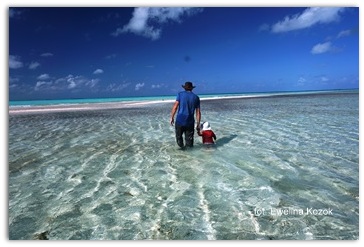
Tarawa
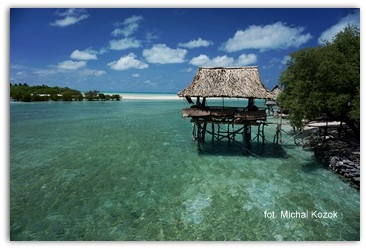 Abatao Island – Tabon Te Keekee Eco Lodge – right at the beginning of the island, close to civilization. The least attractive of the three options, but the closest one
Abatao Island – Tabon Te Keekee Eco Lodge – right at the beginning of the island, close to civilization. The least attractive of the three options, but the closest one
Next island - Santa Faustina Homestay - local owner speaking very good English, ecologically oriented to the world. Huts hung over the water. The possibility of organizing pickup from the airport by boat.
Nabeina Island – Tabuki Retreat – definitely the nicest location, but need a bit of maintenance, nice hosts (although the owner, as in the case of Tabon, is a foreigner), but their English did not allow us for a deeper conversation.

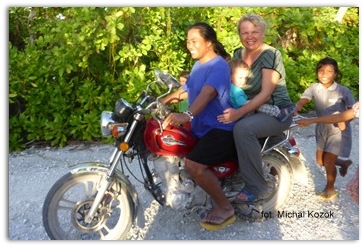
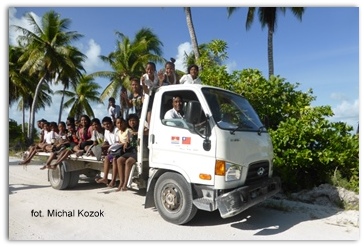 transport – we traveled on the island of Tarawa on foot. The only cost is to go by boat from Buota to Abatao, for one or half dollar (I do not remember), and for a few dollars transfer by minibus from the airport to Buota.
transport – we traveled on the island of Tarawa on foot. The only cost is to go by boat from Buota to Abatao, for one or half dollar (I do not remember), and for a few dollars transfer by minibus from the airport to Buota. 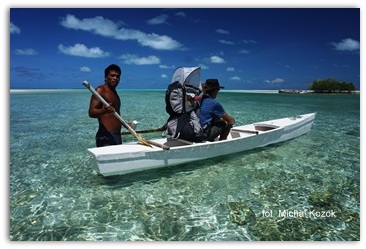 On the way back, we hitchhiked and despite the desire to pay, the locals did not accept money :)
On the way back, we hitchhiked and despite the desire to pay, the locals did not accept money :)
At Abaiang from the airport to the north of the island we rented a truck for fuel costs - AUD 40 (€ 25) for the whole trip. On my way back, I paid the school truck driver AUD 5 and then we hitch the local motobikes, sometimes paying, sometimes for free.
A flight from Tarawa to Aibaiang - AUD 134 round trip for two people and a child, that is around AUD 30 (€ 19) per adult one way. The flight is about 10-15 minutes. You can also catch a motor boat between these islands, about 4-6 hours.

food – it's better to take it with you, because in non-tourist places it's hard to buy anything except fish.
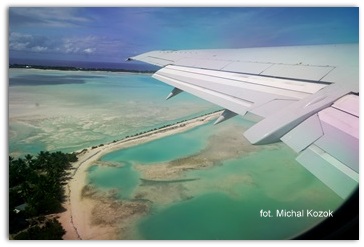 flights – the most popular part of Kiribati is Christmas Island, which has good connection with Hawaii. I visited the western part of the country, with the capital in Tarawa. I flew there from Australia with a stopover in Nauru, and on the way back from Marshall Islands.
flights – the most popular part of Kiribati is Christmas Island, which has good connection with Hawaii. I visited the western part of the country, with the capital in Tarawa. I flew there from Australia with a stopover in Nauru, and on the way back from Marshall Islands.
My international ticket was as follows:
Brisbane – Nauru – Majuro – Tarawa – Brisbane. Total AUD 1678 (€ 1060) per person.
weather – the average temperature throughout the year varies within 30 degrees. The cyclones and rainy season is the period from November to March, the remaining date is the more enjoyable part.
currency – Australian dollar
visa – currently there are no visa requirements for most countries
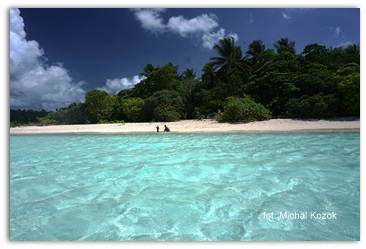

back to the top





![]()








![]()



![]()



![]()





